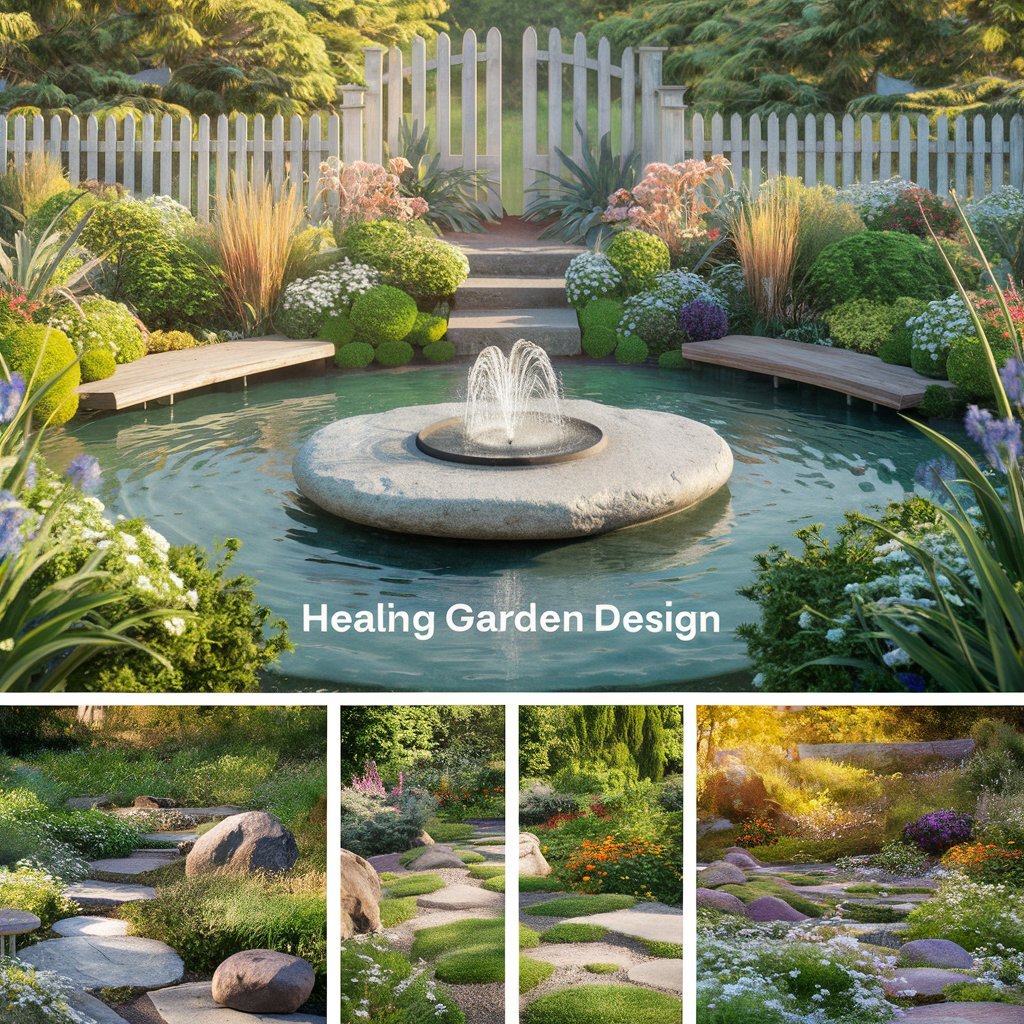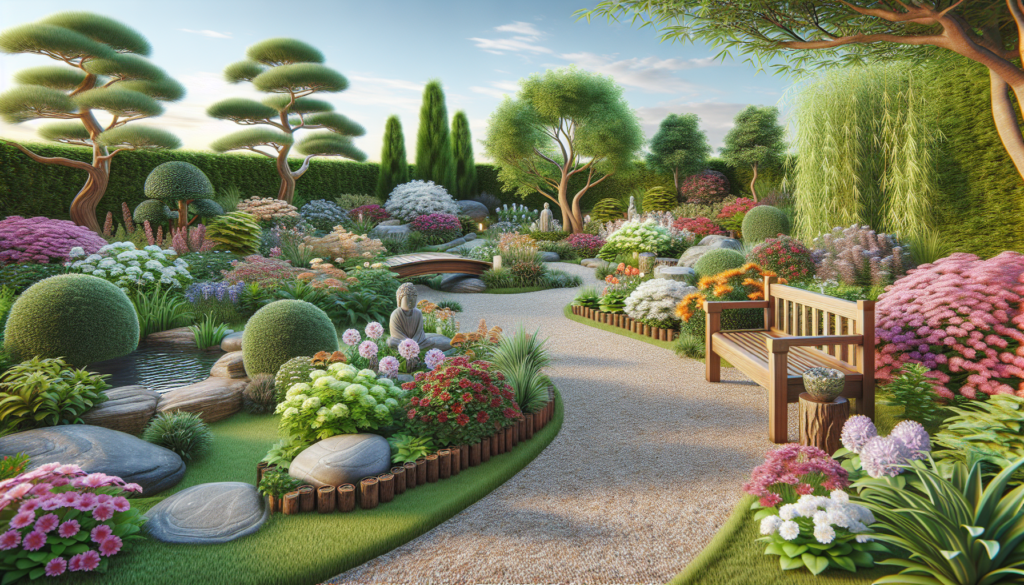Understanding Healing Gardens
Benefits of Connecting with Nature
Spending time in nature does wonders for our bodies and minds. Studies show that being outdoors can lower blood pressure, slow down your heart rate, reduce stress, and lift your mood (Penn State Extension). Nature’s magic doesn’t stop there—it also boosts creativity, sharpens your mind, strengthens your immune system, and helps you feel more connected to others.
| Benefit | What It Does |
|---|---|
| Lower Blood Pressure | Nature helps keep your blood pressure in check. |
| Decreased Heart Rate | Being outside can slow your heart rate. |
| Reduced Stress | Natural settings are great stress-busters. |
| Improved Mood | Nature can make you feel happier. |
| Enhanced Cognitive Function | It boosts your brainpower and creativity. |
| Improved Immune Function | Green spaces make your immune system stronger. |
Just a few minutes outside can start working its magic—lowering blood pressure, slowing your heart rate, and melting away stress (Frontier Landscaping). Plus, nature helps you dodge environmental stressors like pollution, noise, and heat. Green spaces also get you moving, help you connect with others, and give your attention span a much-needed break, making you healthier all around.
Healing Gardens in Healthcare
Hospitals and healthcare facilities are catching on to the benefits of healing gardens. These green havens offer a peaceful escape for patients, their families, and healthcare staff. Take the ‘Secret Garden’ at the Ronald McDonald House of Eastern Wisconsin, for example (Penn State Extension).
These gardens do more than just look pretty—they help medical professionals de-stress, feel more satisfied with their jobs, and stick around longer. Greenery in hospitals can lift moods, ease anxiety, and help prevent burnout among healthcare workers.

| Healthcare Benefits | What It Does |
|---|---|
| Stress Alleviation | Gardens help reduce stress for everyone. |
| Job Satisfaction | Green spaces make healthcare workers happier with their jobs. |
| Retention of Personnel | Healing gardens help keep good medical staff around. |
| Improved Mood | Greenery boosts mood and lowers anxiety. |
| Reduced Burnout | Gardens help prevent burnout among healthcare workers. |
Want to know more about creating your own healing space? Check out our articles on therapeutic horticulture and sensory garden design.
Designing a Healing Garden
Creating a healing garden is all about making choices that bring peace and well-being. Let’s dive into the must-have elements and plant picks that can turn any space into a soothing retreat.
Key Ingredients for a Healing Garden
To whip up a garden that boosts mental wellness, we need to focus on a few key ingredients. These bits and pieces help create a calm spot where folks can chill out and connect with nature.
Paths and Places to Sit: Comfy seats and easy-to-walk paths invite people to hang out in the garden. Paths should be wide enough for everyone and made from materials that look natural.
Water Features: The gentle sound of water from fountains or ponds can help folks relax. Plus, water features attract birds and other critters, adding some extra life to the garden.
Sensory Stuff: Adding plants and features that tickle all five senses is a big deal. Think fragrant flowers, textured leaves, and rustling grasses. These can help lower stress and lift spirits. For more ideas, check out our sensory garden design.
Shade and Shelter: Shaded spots with pergolas, arbors, or big trees make the garden comfy even on sunny days. Blocking the wind also helps keep things calm.
Art and Sculptures: Artsy touches can make the garden more interesting and meaningful. Think about adding sculptures, mosaic paths, or fancy benches that match the garden’s vibe and what visitors like.
Picking Plants for Healing
Choosing the right plants is a big part of making a healing garden. Plants should look good and make people feel good too. Here are some plant picks to think about:
Herbs for Tea: Growing plants for soothing teas adds a fun, interactive element. Anise hyssop, catnip, chamomile, and lemon balm are great choices (Penn State Extension).
Culinary Herbs: Adding herbs like chives, fennel, rosemary, sage, thyme, and oregano can boost the sensory experience and be useful in the kitchen.
| Plant Type | Benefits |
|---|---|
| Anise Hyssop | Calming tea, attracts pollinators |
| Catnip | Calming tea, repels insects |
| Chamomile | Calming tea, helps with relaxation |
| Lemon Balm | Calming tea, smells like lemon |
| Chives | Good for cooking, pretty flowers |
| Fennel | Good for cooking, smells nice |
| Rosemary | Good for cooking, invigorating scent |
| Sage | Good for cooking, has medicinal uses |
| Thyme | Good for cooking, makes a nice ground cover |
| Oregano | Good for cooking, smells great |
Pretty Plants: Adding perennials and shrubs that look good all year is key. Lavender, for example, looks nice and smells calming. Ornamental grasses and flowering perennials can add texture and color.
Native Plants: Using plants that are native to your area helps local wildlife and makes the garden easier to take care of. Native plants are used to the local weather and soil, so they’re tougher and need less fuss.
By picking the right plants and adding the right elements, we can create healing gardens that are perfect for mental wellness. For more peaceful gardening ideas, visit our peaceful garden ideas section.
Crafting Your Healing Garden
Designing a garden that soothes the soul isn’t just about planting flowers—it’s about creating a space that feels like a warm hug. By playing with colors, textures, and heights, you can turn your backyard into a sanctuary that boosts your mood and brings peace.
Colors and Textures That Speak to You
When picking colors for your garden, think about what makes you smile. Bright colors like reds and yellows can give you a burst of energy, while soft blues and greens can help you unwind. Choose shades that make you feel good.
Textures matter too. Go for plants that feel nice to touch—skip the prickly ones. Soft, velvety leaves or feathery grasses can make your garden feel inviting. And don’t forget the smells! Aromatic plants like lavender or rosemary can make your garden smell amazing and help you relax.
| Color | How It Feels |
|---|---|
| Bright Colors | Energizing, uplifting |
| Soft Shades | Calming, soothing |
| Aromatic Plants | Relaxation, joy |
Playing with Heights and Layers
Adding some height to your garden can make it more interesting. Think about using trellises, tall plants, or even small trees to draw the eye upward. This can make your garden feel more spacious and serene (Longwood Gardens).
Layering different heights of plants can also add depth. Mix ground covers with mid-height shrubs and taller plants to create a lush, immersive environment. This not only looks good but also makes your garden feel more engaging.
| Element | What It Does |
|---|---|
| Vertical Elements | Adds interest, draws eye upward |
| Layering Plants | Adds depth, creates immersion |
| Tall Plants | Provides privacy, creates cozy spots |
By blending these elements, you can create a garden that’s not just pretty to look at but also good for the soul. Whether you’re picking colors that make you happy or adding layers to make your garden feel more alive, each choice helps turn your space into a peaceful retreat. For more tips, check out our articles on sensory garden design and peaceful garden ideas.
Crafting Your Healing Garden
Creating a healing garden isn’t just about planting flowers; it’s about designing a space that nurtures the soul and calms the mind. Let’s break down how to make this happen.
Boosting Wellness with Plants
Plants are the heart and soul of any healing garden. They don’t just look pretty; they can actually make you feel better. Here are some plants that can turn your garden into a wellness retreat:
| Plant | Benefit |
|---|---|
| Anise Hyssop | Calming, helps digestion |
| Catnip | Eases stress, mild sedative |
| Chamomile | Reduces anxiety, aids sleep |
| Lemon Balm | Lifts mood, relieves stress |
| Lavender | Aromatherapy, fights insomnia |
| Echinacea | Boosts immunity |
| Rosemary | Enhances memory, cognitive aid |
References:
Imagine walking through a garden filled with the soothing scents of lavender and chamomile. Not only do these plants smell amazing, but they also help reduce stress and improve your mood. And if you love cooking, herbs like rosemary can boost your memory while adding flavor to your dishes. For more plant ideas, check out plants for stress relief.
Adding Design Elements
To make your garden truly therapeutic, you need to think about more than just plants. Here are some design tips to create a space that feels like a sanctuary:
1. Water Features: A small fountain or pond can add the soothing sound of running water, which helps reduce stress and create a peaceful vibe.
2. Natural Materials: Use stone, wood, and gravel to give your garden a natural feel. Stone paths can guide you through the garden, encouraging you to take a mindful stroll.
3. Color and Texture: Mix different colors and textures to keep things interesting. Soft greens, bright flowers, and varied foliage can make your garden visually stimulating.
4. Resting Spots: Add benches, hammocks, or garden chairs so you can sit and soak in the beauty. These spots are perfect for meditation or just unwinding.
5. Garden Art: Sculptures, wind chimes, and bird feeders can add a touch of whimsy and attract birds and butterflies, making your garden even more delightful.
6. Welcoming Entrance: An inviting entrance with an archway or gate can set the tone for your garden, making it feel like a special place right from the start.
References:
By choosing the right plants and adding thoughtful design elements, you can create a healing garden that offers a break from the hustle and bustle of daily life. For more ideas, visit peaceful garden ideas.

My name is Michelle Warren, and I’m the founder of Peaceful Gardening. As a 10-year breast cancer survivor, I’ve discovered the profound therapeutic power of gardening. This journey has not only helped me recover but has also become my passion and a source of ongoing peace and joy.
Peaceful Gardening was born from my desire to share the healing benefits of gardening with others. Whether you’re facing health challenges, dealing with stress, or simply looking to connect more deeply with nature, this space is for you.
Over the past decade, I’ve cultivated not just plants, but a deep understanding of how gardening can positively impact mental health. I’ve worked with local community gardens, led workshops on mindful gardening practices, and collaborated with mental health professionals to develop gardening-based stress reduction programs.
Peaceful Gardening was born from my desire to share the healing benefits of gardening with others. Whether you’re facing health challenges, dealing with stress, or simply looking to connect more deeply with nature, this space is for you.
Here, you’ll find evidence-based advice on using gardening as a tool for mindfulness, stress relief, and emotional healing. I share personal stories, practical tips, and scientifically-backed information on how to create your own therapeutic garden space, no matter the size of your yard or balcony.
My mission is to help you discover the joy, peace, and healing that comes from nurturing plants and connecting with nature. Join me in exploring how the simple act of tending to a garden can transform your mental and emotional wellbeing.
Welcome to Peaceful Gardening – let’s grow together towards better mental health!”

